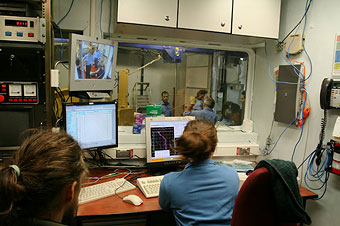

 | |||||||||
|
|
Journals 2007/2008Jason Pavlich
December 29, 2007 Position 71° 23.500' N 125° 07.914' W I awoke at 6:30 am, and headed down to deck 6 for some coffee. The cafeteria has a coffee machine that can also make an addictive 50/50 blend of hot chocolate and coffee. I went for the straight coffee today. Water was needed this morning for two purposes. Eighty liters was required to change the water in the copepods' jars. Without normal circulation to disperse the waste and a fresh supply of dissolved oxygen, the copepods would die within days, well short of their normal 5-7 life span. Another 24 L was needed for the study of the distribution of HCH throughout the water column. Two cups of coffee later, the rosette was making its way out of the water in the moon pool and we began to gather our samples. Monika had selected the depth of 200 m to collect the water for the copepods. She had watched the profile of the water column recorded by the CTD as it fell. The salinity level slowly increased with increasing depth until it leveled out around 200 m. It is in this region where the copepods are most likely residing this time of year, so it made the most sense to take the water from there. For the HCH study, 4 L samples of water were taken from depths of 25 m, 50 m, 100 m, 150 m, 200 m, and the bottom. I showed my confidence in my ability to collect water from the rosette by not wearing my waterproof shoes.
Wojiech and I carried the water back to aft lab for purification and filtration. He then resumed measuring and cutting the ice cores taken several days ago based on their distinct layers. Monika worked on melting the sections Wojiech was preparing. The melted sections of ice will eventually be run through the HCH cartridges just like the seawater samples. I handled setting up the HCH water column filtrations. The HCH study is the main focus of Monika's project for her PhD. I was happy that she felt confident enough in me to run the samples in the correct fashion. Since she is looking at the distribution of HCH in the Arctic ice and water column, all of her data for this station would be meaningless, if I screwed up. It is nice to feel trusted. The six samples have to be run in two sets and this eats up most of the day. Since the -20°C room is right next door, I also helped Amanda shave and bag some of her ice cores samples for her mercury study. An announcement was made at about 7 pm that we will be on the move by 8 tomorrow morning. Moving through the ice could mean disaster for an unkempt lab, so as the samples were finished, the equipment was tied down to the lab bench, chemicals were put away, and Wojiech's copepods jars were secured. Too much time and effort had been put into these creatures to wake up in the morning and find them spilled all over the floor. I am looking forward to moving locations tomorrow. A new station will mean more sampling and another few hours of coring on the ice. We can't get there fast enough. |
||||||||
